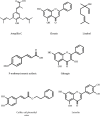Research Progress on Therapeutic Effect and Mechanism of Propolis on Wound Healing
- PMID: 35911156
- PMCID: PMC9334088
- DOI: 10.1155/2022/5798941
Research Progress on Therapeutic Effect and Mechanism of Propolis on Wound Healing
Abstract
Propolis is a kind of reduct collected by bees from various plant sources. Because propolis is a mixture, it has a variety of biological activities, excellent anti-inflammatory and bactericidal effects. Especially in the treatment of infectious wounds, acute wounds, burns, and scalds and promoting wound healing, more and more scientists began to apply it to the research field of wound healing. The standard preparation of propolis combined with other compound components has a safer and less toxic effect in the treatment of trauma. In order to more effectively use propolis products in wound treatment. This paper reviews the effect and treatment mechanism of propolis on different types of wound healing, as well as the synergistic effect of propolis and other compounds, in order to provide ideas for the further exploration of the biological activity and pharmacological function of propolis in the future, as well as its in-depth development in the field of wound healing. It will also provide a theoretical reference for the further development and utilization of propolis.
Copyright © 2022 Juan Yang et al.
Conflict of interest statement
The authors confirm that this article content has no conflicts of interest.
Figures


Similar articles
-
Historical and modern research on propolis and its application in wound healing and other fields of medicine and contributions by Polish studies.J Ethnopharmacol. 2020 Nov 15;262:113159. doi: 10.1016/j.jep.2020.113159. Epub 2020 Jul 28. J Ethnopharmacol. 2020. PMID: 32736052
-
Potential role of propolis in wound healing: Biological properties and therapeutic activities.Biomed Pharmacother. 2018 Feb;98:469-483. doi: 10.1016/j.biopha.2017.12.069. Epub 2017 Dec 27. Biomed Pharmacother. 2018. PMID: 29287194 Review.
-
Anti-Inflammatory and Histological Analysis of Skin Wound Healing through Topical Application of Mexican Propolis.Int J Mol Sci. 2023 Jul 23;24(14):11831. doi: 10.3390/ijms241411831. Int J Mol Sci. 2023. PMID: 37511590 Free PMC article.
-
Use of propolis for skin wound healing: systematic review and meta-analysis.Arch Dermatol Res. 2023 May;315(4):943-955. doi: 10.1007/s00403-022-02455-8. Epub 2022 Nov 23. Arch Dermatol Res. 2023. PMID: 36418601
-
Synergistic Effect of Honey and Propolis on Cutaneous Wound Healing in Rats.Acta Med Iran. 2016 Apr;54(4):233-9. Acta Med Iran. 2016. PMID: 27309263
Cited by
-
Propolis Stands out as a Multifaceted Natural Product: Meta-Analysis on Its Sources, Bioactivities, Applications, and Future Perspectives.Life (Basel). 2025 May 9;15(5):764. doi: 10.3390/life15050764. Life (Basel). 2025. PMID: 40430191 Free PMC article. Review.
-
Effect of Brazilian green propolis in chronic ulcer treatment: a randomized clinical trial.Rev Bras Enferm. 2024 Sep 6;77(4):e20230418. doi: 10.1590/0034-7167-2023-0418. eCollection 2024. Rev Bras Enferm. 2024. PMID: 39258606 Free PMC article. Clinical Trial.
-
Antimicrobial Potential of Bee-Derived Products: Insights into Honey, Propolis and Bee Venom.Pathogens. 2025 Aug 6;14(8):780. doi: 10.3390/pathogens14080780. Pathogens. 2025. PMID: 40872290 Free PMC article. Review.
-
Neutrophil Immunomodulatory Activity of Nerolidol, a Major Component of Essential Oils from Populus balsamifera Buds and Propolis.Plants (Basel). 2022 Dec 6;11(23):3399. doi: 10.3390/plants11233399. Plants (Basel). 2022. PMID: 36501438 Free PMC article.
-
Honey-Propolis-Engineered Collagen Peptides as Promising Wound-Healing Matrix in Mouse Model.Molecules. 2022 Oct 20;27(20):7090. doi: 10.3390/molecules27207090. Molecules. 2022. PMID: 36296681 Free PMC article.
References
-
- Farstvedt E., Stashak T. S., Othic A. Update on topical wound medications. Clinical Techniques in Equine Practice . 2004;3(2):164–172. doi: 10.1053/j.ctep.2004.08.003. - DOI
-
- Chen J., Han C. M., Lin X. W., Tang Z. J., Su S. J. Effect of silver nanoparticle dressing on second degree burn wound. Zhonghua Wai Ke Za Zhi . 2006;44(1):50–52. - PubMed
Publication types
LinkOut - more resources
Full Text Sources

